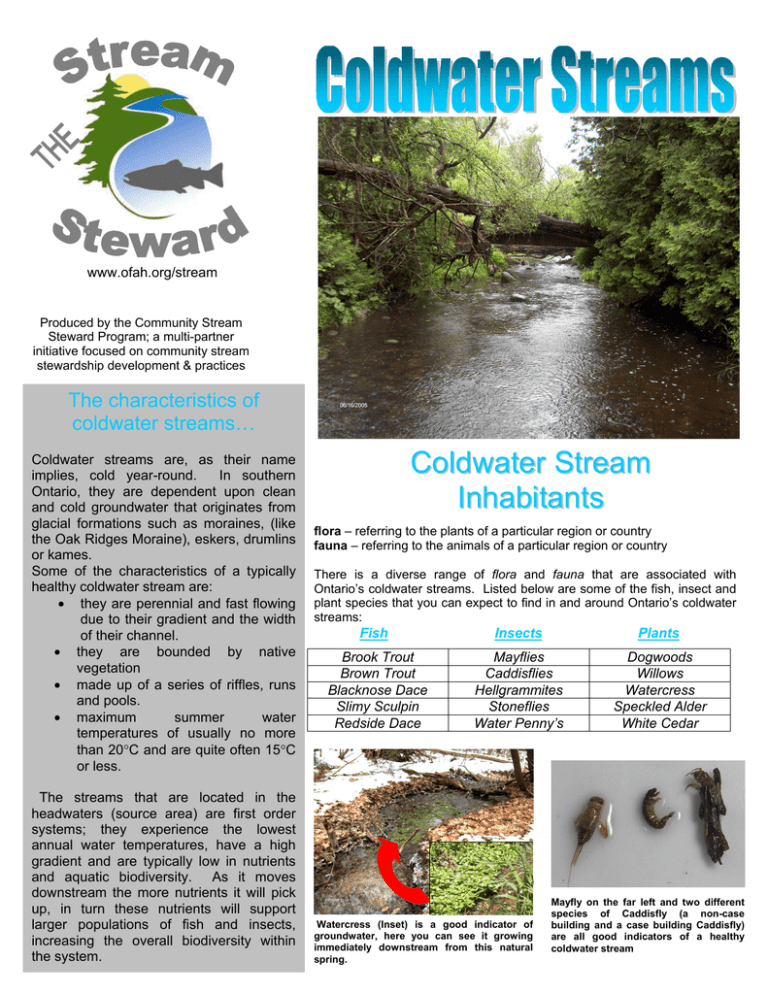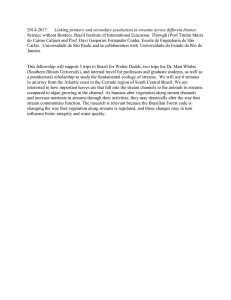Coldwater Streams - Ontario Federation of Anglers and Hunters
advertisement

www.ofah.org/stream Produced by the Community Stream Steward Program; a multi-partner initiative focused on community stream stewardship development & practices The characteristics of coldwater streams… Coldwater streams are, as their name implies, cold year-round. In southern Ontario, they are dependent upon clean and cold groundwater that originates from glacial formations such as moraines, (like the Oak Ridges Moraine), eskers, drumlins or kames. Some of the characteristics of a typically healthy coldwater stream are: • they are perennial and fast flowing due to their gradient and the width of their channel. • they are bounded by native vegetation • made up of a series of riffles, runs and pools. • maximum summer water temperatures of usually no more than 20°C and are quite often 15°C or less. The streams that are located in the headwaters (source area) are first order systems; they experience the lowest annual water temperatures, have a high gradient and are typically low in nutrients and aquatic biodiversity. As it moves downstream the more nutrients it will pick up, in turn these nutrients will support larger populations of fish and insects, increasing the overall biodiversity within the system. Coldwater Stream Inhabitants flora – referring to the plants of a particular region or country fauna – referring to the animals of a particular region or country There is a diverse range of flora and fauna that are associated with Ontario’s coldwater streams. Listed below are some of the fish, insect and plant species that you can expect to find in and around Ontario’s coldwater streams: Fish Insects Plants Brook Trout Brown Trout Blacknose Dace Slimy Sculpin Redside Dace Mayflies Caddisflies Hellgrammites Stoneflies Water Penny’s Dogwoods Willows Watercress Speckled Alder White Cedar Watercress (Inset) is a good indicator of groundwater, here you can see it growing immediately downstream from this natural spring. Mayfly on the far left and two different species of Caddisfly (a non-case building and a case building Caddisfly) are all good indicators of a healthy coldwater stream The Importance of Coldwater Streams Impacts Upon Coldwater Streams riparian – of or relating to or located on the banks of a river or stream. Coldwater streams are highly susceptible to poor land-use management, such as: • habitat destruction • urbanization • channelization • increased nutrient levels By removing or displacing the native vegetation that borders coldwater streams, processes such as erosion, poorer water quality and the introduction of non-native species can occur. In Southern Ontario, the effects of urbanization are all around us and the impact that it can have on streams can be profound. Activities that often accompany urbanization are erosion, sedimentation and an increase in impervious surfaces (ie. roads and parking lots). Improper water control activities, like the straightening of channels can increase the chances of a stream drying up during low water flow periods. By following established best management practices in and around streams the abovementioned impacts could be greatly minimized, if not avoided all together. Coldwater streams are the primary systems within a watershed making their health extremely important to all of the connected streams, rivers and ultimately, lakes throughout the watershed. These vitally important coldwater streams act to control excess sediment and nutrients from entering the lower portions of a watershed, which means better overall water quality, biodiversity and improved recreational opportunities. They are also vital in controlling water levels, whether it is in times of drought or in the event of a flood. A healthy coldwater system will sustain the larger, lower portions through a steady base flow from the headwaters. Their importance also extends to terrestrial wildlife as the native vegetation that binds the riparian zones are effective wildlife corridors. The two pictures below are of coldwater streams in Southern Ontario. Of these two streams, which would you rather have in your community? For more information on coldwater streams and rivers, stewardship activities and / or restoration options, contact: The Community Stream Steward Program at: c/o Ontario Federation of Anglers & Hunters 4601 Guthrie Drive Peterborough, Ontario K9J 8L5 (705) 748-6324 stream_steward@ofah.org Developed and produced with funding provided by the Ontario Trillium Foundation and the Oak Ridges Moraine Foundation VS.




